How to Prepare and Protect Your Pets from a Natural Disaster

A dog is man’s best friend. Do you agree?
As terrifying and devastating as natural disasters may be, everything will be alright in the end, as long as you and your family are safe and sound. Property damage can be restored and ruined possessions – replaced, but the loss of a loved one cannot be fixed or compensated for. Therefore, it is the safety and well-being of your family members that you need to ensure, above anything else, in the event of a disaster. Creating an efficient emergency preparedness plan is one of the first things you can do to increase your chance of survival and quick recovery, should the unthinkable happen. Just make sure you develop a detailed, reliable plan that will allow you to keep everyone in your household – including your dear pets – safe and healthy.
Without a doubt, you consider your beloved animal companions part of the family and would make every effort to ensure their well-being. In the event of an emergency, however, your pets will be at great risk, as well as everyone else in the home. To successfully avert the danger and keep your animals friends safe and secure, you need to be well prepared.
Pet Disaster Preparedness
To protect your pets from a natural disaster, you need to take some crucial precautionary measures well in advance:
1) ID your pet. Provide your pet with reliable identification (a microchip or a collar ID tag). Make sure the information included in the chip and/or identification tag is correct and up-to-date. Don’t forget to add your name and telephone number on your pet’s collar tag. Proper identification will ensure your reunion with your animal friend in case you get separated during an emergency.
It is also a good idea to keep a current photo of your pet with you for identification purposes.
2) Prepare a pet emergency kit. An emergency supply kit for your pet will allow you to ensure your animal companion’s well-being during a disaster and provide for their specific needs. Your pet disaster kit should contain:
-
- Transportation carrier or cage, clearly labeled with your contact information;
- Leash and harness (if applicable);
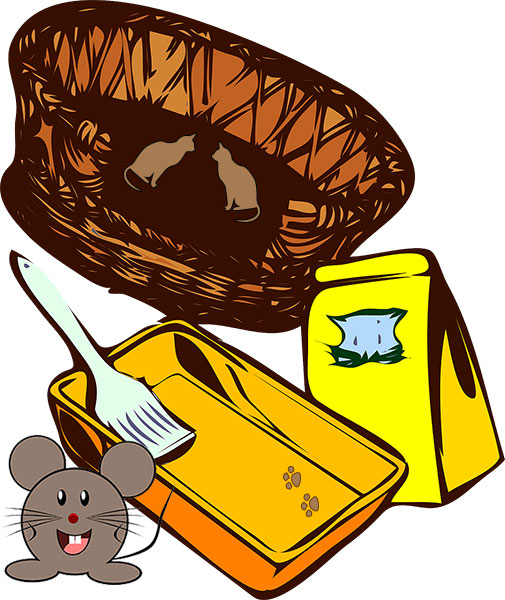
Your pet emergency kit will be a lifesaver in case of a natural disaster.
- Pet food and water supplies for about 5 days, as well as bowls and dishes (or other adequate food and water receptacles) and a manual can opener;
- Your pets’ medications and a first-aid kit;
- Copies of your pet’s medical and vaccination records, as well as your veterinarian’s name and phone number;
- Copies of important documents, such as micro-chip numbers, registration information, proof of purchase, adoption records, etc.;
- Litter box and litter, paper towels, newspapers, plastic trash bags, and other sanitary materials;
- A few of your pets’ favorite toys, blankets, etc.;
- Any specialized pet items, such as spray bottles (to hydrate birds’ feathers and lizards’ scales), blankets (to cover the cages and keep them warm), heating pads (for snakes and other reptiles), bedding material (for small rodents), and so on.
Store your pet’s emergency supplies in a water-proof container and keep it in a safe and convenient place, so that you can easily grab it on your way out during an evacuation. Don’t forget to replace food supplies at regular intervals, so that they are always fresh. Medications should also be checked and replaced a couple of months before their expiration dates.
3) Find appropriate shelters. When a disaster strikes, it will be too late to begin searching for pet-friendly hotels or emergency shelters that allow pets. You are strongly advised to find safe places where you can stay with your pet in the event of an emergency well ahead of time:
- Call your local emergency management office to get all the relevant information you need;
- Find out if certain shelters in your area will accept pets in an emergency situation;
- Locate pet boarding facilities in your area (search for some good boarding facilities outside your local area as well, because local facilities may have to close during a disaster). Make a list of boarding kennels, veterinary clinics, and animal shelters that will care for pets in emergency situations (make sure you have their addresses and phone numbers). Have in mind that boarding facilities will need your pet’s medical records;
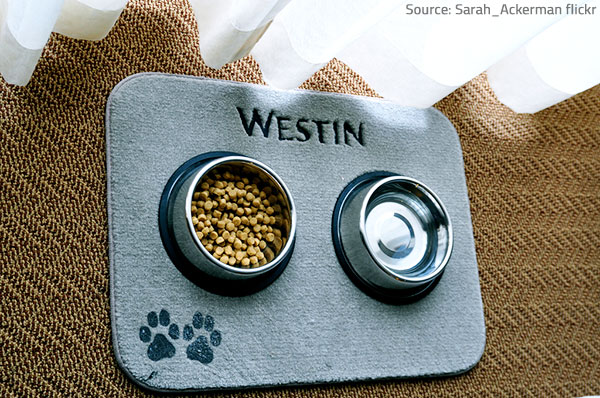
You need a safe haven where you and your pet will be secure and comfortable during an emergency.
- Find pet-friendly hotels or motels where you will be able to take shelter in the aftermath of a disaster – contact them in advance and ask about any restrictions on the number, size, or species of pets they accept;
- Ask friends and relatives who live outside your immediate area if they are willing to shelter your animal friends in the event of an emergency.
4) Take precautions in case you are not at home when a disaster strikes. If you have to leave your pet at home alone, you are recommended to:
- Never leave your pet tied up outside;
- Confine your animal friends to a safe area inside your home – leave them loose in an interior room with adequate air flow and no windows;
- Provide enough food and water for several days;
- Leave a dripping faucet as a water source (make sure the sink drain is open);
- Give a neighbor or a friend (someone who is familiar with your pet) a spare key to your home and ask them to take your animal companion to safety in case of emergency (provided that there are no risks involved, of course). Show your emergency caretaker where your pet is likely to hide and where your emergency supplies are stored. Designate a meeting place where you can find that trusted person and your pet after the disaster;
- Put a pet rescue sticker on your front door to alert people that there are pets inside. Make sure the rescue decal includes information about the types and number of pets in your home, their most probable location, and your contact information (as well as your veterinarian’s name and phone number).
To be fully prepared, make sure your pet emergency plan covers pet safety during a disaster as well.
Pet Protection during a Natural Disaster
Your pets won’t be able to survive a disaster on their own – you need to take proper care of them during the emergency situation.
If you need to evacuate:
-
- Take your animal friends with you – pets left behind in a disaster can easily get lost, malnourished, injured, or even killed;
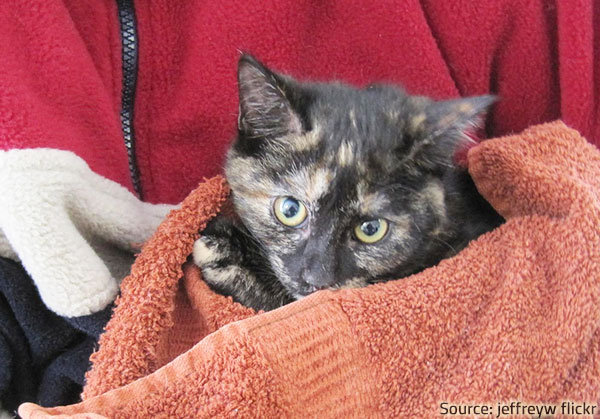
Your pets will be in good hands if they are with you, no matter what happens.
- Allow plenty of time to catch and load your pets in their carriers – your animal friends will be frightened by all the commotion and alarming sounds and smells around them, which will make it difficult to load them into their carriers. It is a good idea to learn where your pets like to hide in your home (they will certainly hide when they are scared), as finding them quickly will help you evacuate faster;
- Make sure your pets have identification securely fastened to them;
- Take your pet emergency kit;
- Call your chosen animal evacuation site and make reservations;
- Evacuate early – if your area is on alert for a natural disaster, evacuating before the conditions become severe will ensure everyone’s safety and will make the process less stressful. Besides, the earlier you leave the disaster area, the easier it will be to find shelter for you and your pets (especially if you don’t have reservations).
If you stay home:
- Designate a safe area of your home where you can stay together with your pets – it is advisable to identify this “safe room” well in advance and keep your emergency supplies (including your pet disaster kit) there;
- Secure the area – close off unsafe nooks and crannies where frightened animals may try to hide; take away dangerous items such as tools or toxic products; close off any openings (vents, pet doors, etc.) with plastic sheeting and strong tape; etc. – take every precaution that is applicable in your case;
- Bring your pets indoors – take your animal friends inside as soon as you learn of an approaching disaster. Your pets will feel safer in the familiar surroundings, especially if you are there as well;
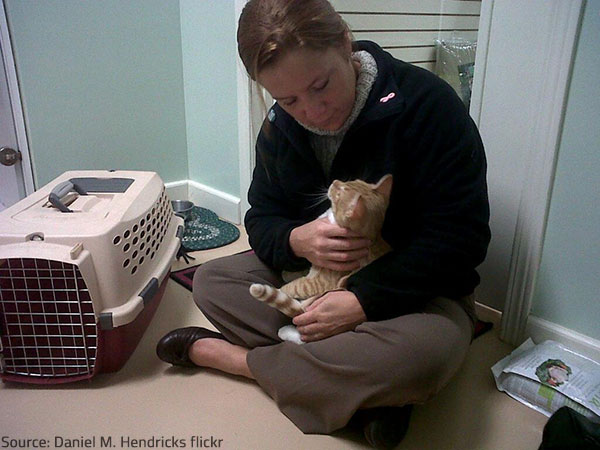
Everything will be alright in the end, as long as everyone you care about is safe and sound.
- Place your pets inside their carriers or cages – this will prevent them from running away, will help reduce their stress and will allow you to evacuate faster if it becomes necessary;
- Make sure your pets have some sort of identification fastened to them;
- Feed your pets moist or canned food during the emergency period, so that they don’t need to drink too much water;
- Listen to the radio for updates and important information and don’t come out of your home until the danger has passed.
Our pet emergency preparednessPreparedness is the state of being ready to respond to emerg... More checklist ends with several useful tips on how to care for your pets after a disaster.
Pet Safety after a Natural Disaster
The post-disaster period may be quite stressful and chaotic – you may have to hire professional disaster restoration and cleaning services to restore your home to its previous good condition, you may not be able to resume your normal daily routine for a couple of months, etc. Your pets will be scared, disoriented and stressed in the changed environment, so you need to be very careful and very patient with your animal friends in the period after an emergency.
1) Prevent pets from escaping and/or getting lost. Don’t allow your pets to roam loose in the post-disaster period (keep dogs on leashes, cats – in carriers, birds, reptiles and small rodents – in their cages, etc.). Familiar landmarks and smells might be gone which will confuse and frighten your pets – under such circumstances they may try to escape or get lost, so make sure you maintain close contact with them all the time.
2) Prevent pets from getting injured. Keep your pets away from dangerous areas (such as flooded basements, for example) and potential hazards (like downed power lines). Have in mind that snakes and other dangerous animals may be brought into the area in case of floodingFlooding is the overflow or accumulation of water in areas t... More. Wildlife can pose a threat to you and your pets, so you need to take quick and efficient precautionary measures.
3) Prevent emotional traumas and health problems.
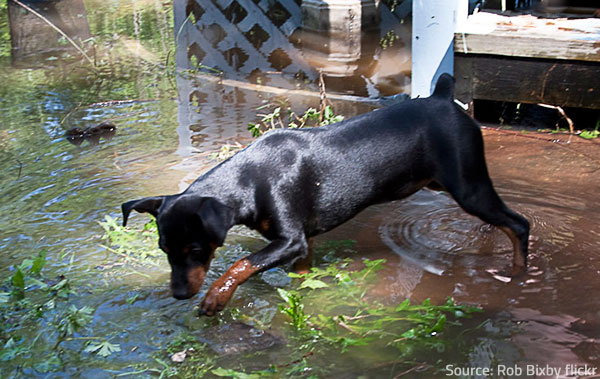
Make every effort to keep your pet safe and happy after an emergency.
Your pet’s behavior may change after an emergency – normally quiet and friendly pets may become aggressive or defensive, otherwise healthy animals may lose appetite or may experience trouble sleeping, etc. Watch your pets closely and make every effort to get them back to their normal routines as soon as possible. If possible, keep your pets confined to a safe and familiar place for several days after the disaster – a fenced yard with access to shelter and water, an interior room, etc. Spend more time than usual with your animal friends, show them your love and care, and try to reassure them that everything is fine. If behavioral problems persist or if your pet seems to have any health problems after the emergency, contact your veterinarian without delay.
Proper disaster preparednessPreparedness is the state of being ready to respond to emerg... More may mean the difference between life and death for you, your family, and your pets. So, spare no effort and prepare well in order to stay safe and successfully weather the storm, whatever happens.












